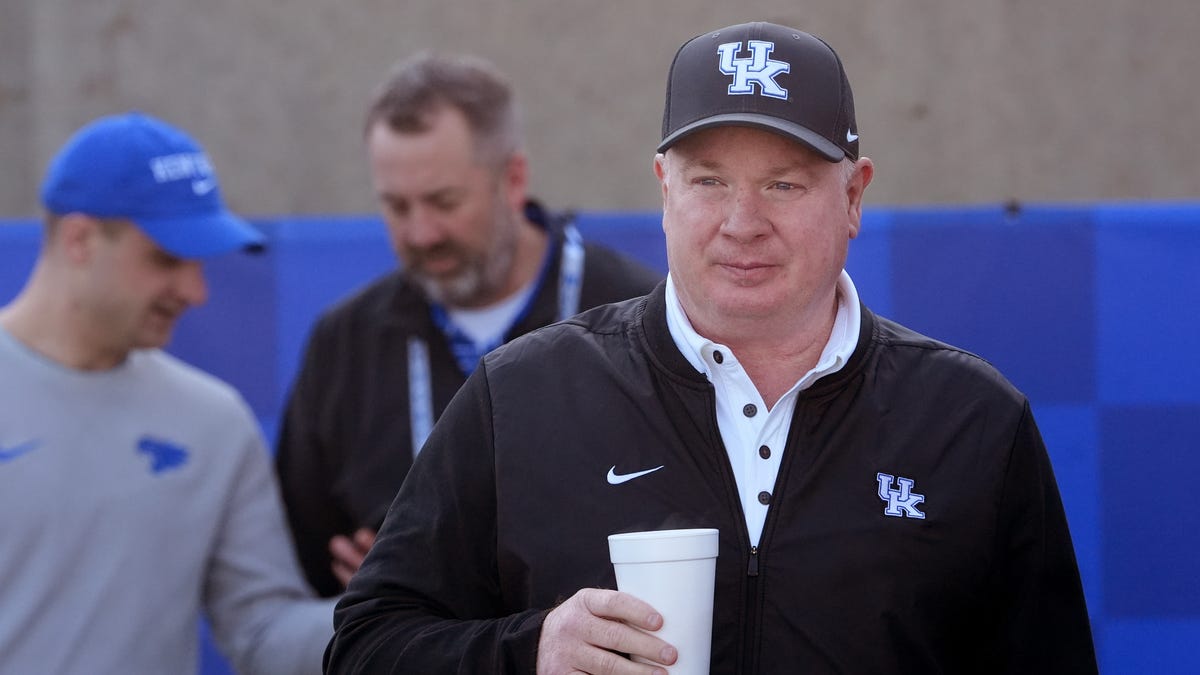Kentucky
If Kentucky Can Green Up, So Can Every State

BOONEVILLE, KY – APRIL 20: The 2010 U.S. Census listed Owsley County as having the lowest median … [+]
Getty Images
Kentucky is finally seeing the light, deploying increasingly more renewable energy projects — an attempt to emerge from a coal-based economy. A handful of clean energy projects are springing up in the state.
Make no mistake: the state is rooted in coal, which still has its teeth firmly implanted there — a fuel that attracted legacy manufacturing companies such as steel. However, things are evolving due to changing times and cheaper fuels. For example, Nucor
NUE
NEE
“Nucor’s success in Kentucky has grown significantly in recent years, with major new investments and jobs helping to expand the reach of its steel products,” said Kentucky Governor Andy Beshear. “Whether it’s electric vehicles or cutting-edge metals manufacturing, Kentucky is emerging as a national leader in creating the jobs of the future.”
It’s a two-phase solar project, expected to produce 400 MW ultimately. Phase one starts this fall. NextEra’s unit, Sebree Solar, is building the solar farm.
Change is urgent, according to a book released last week: “The Injustice of Place.” The authors started with the premise that poverty permeates urban America, but found that the nation’s hardest-hit places are in rural regions — ones with inferior schools and decaying social infrastructures. That includes bowling alleys, hair salons, and eating establishments.
“Place is hugely determinative — it determines to a large extent how things turned out for us. And I think as an individualistic culture, we really strain to believe that,” Kathryn Edin told 19th News.
Edin, a professor of sociology at Princeton University, is one of three authors who emphasized that the rural communities they studied included places of color. The book looks beyond Appalachia, concluding the regions in question had been exploited by single industries and white elites, paying poor wages with equally penurious working conditions.
People despair, resulting in runaway opioid usage to ease the pain. After World War II, Kentucky’s coal mining industry employed 75,000 miners. Today, that number is 4,000. And politicians have preyed on their anxieties, telling them that the industry’s return is near. Even the most disheartened now understand that they must find new opportunities with long-lasting prospects.
A New Era for Appalachia?
CUMBERLAND, KENTUCKY – AUGUST 26: A truck is loaded with coal at a mine on August 26, 2019 near … [+]
Getty Images
Welcome solar, booming in the southwest and finding homes in Texas, Florida, and New York. Other Appalachian states like West Virginia are also exploring the option.
Duke Energy is building one of Kentucky’s most extensive solar arrays — 5,600 photovoltaic panels on the 800,000-square-foot Amazon Air Hub rooftop. It is adjacent to the Cincinnati/Northern Kentucky International Airport. This facility will feed up to 2 megawatts of solar power directly onto the electric distribution grid, energizing roughly 400 homes and businesses in the area.
The catalyst is Amazon, which aims to run all of its global operations on renewable energy by 2040.
And last month, the Kentucky Municipal Energy Agency and RWE Clean Energy broke ground on a facility that will generate 86 MW with 226,000 solar panels. The energy agency will buy the output from RWE in a 20-year power purchase agreement. It will power 15,000 homes and provide about 15% of the area’s electricity needs by June 2024.
Meantime, PPL
PPL
Perhaps the most illustrative example of Kentucky’s enlightenment is converting the state’s biggest coal mine into a solar energy center. In July, BrightNight, Rivian Automotive, and the Nature Conservancy said the Starfire Mine would become the BrightNight Starfire Renewable Energy Center — set to produce 800 MW of electricity and power 170,000 homes.
Rivian will buy the output to power electric transportation. Construction will start in 2025 and take place over four phases. During the first phase, Rivian will buy 100 MW from BrightNight, which will power up to 450 million miles of renewable driving annually. The Nature Conservancy will purchase 2.5 MW to complement its onsite solar arrays. When developers complete the $1 billion plant, it will be Kentucky’s largest renewable power project.
“Shifting our energy system to carbon neutrality goes beyond electrifying the roughly 1.5 billion vehicles in the global fleet,” said Rivian Founder and Chief Executive RJ Scaringe. “We must also support the decarbonization of our energy infrastructure through the responsible deployment of renewable energy.”
Joining the National Trend
PALM SPRINGS, CA – MARCH 27: Giant wind turbines are powered by strong winds in front of solar … [+]
2013 Getty Images
Kentucky’s moves are part of a national trend. The U.S. Energy Information Administration said the country added 16,800 MW during the first half of 2023. Solar provided 5,900 MW of that, while natural gas supplied 5,700 MW. Wind energy made up 3,200 NW, and battery storage comprised 1,800 MW.
The same agency says that Kentucky finishes last among the states for wind and solar generation — something that might change once the developing projects come online. Like other coal-producing states, Kentucky has come kicking and screaming into the new energy era, brought on by the climate change phenomenon, falling wind and solar prices, and plummeting coal sales.
But Appalachia needs to evolve faster. Indeed, the time to have ditched the horse and buggy was 15 years ago.
“The absence of a renewable portfolio standard has been a major factor in our backwardness,” said Andy McDonald, a clean energy advocate, in an Inside Climate News story. “The coal industry has had such a grip on the (Kentucky) legislature and the governorship, and the culture, it’s really held back policies that would have supported renewables.”
However, economies can move forward. And Kentucky could become an example not just to others in Appalachia but to the rest of the country — if the most recent renewable projects are a precursor of what will come.

Kentucky
Will Kentucky have Medicaid work requirements? What the state is planning under new law

Facts About the Kentucky General Assembly
Discover key facts about the Kentucky General Assembly, including its history, structure, and state government functions.
- Kentucky plans to implement new Medicaid work requirements for certain “able-bodied” adults.
- The program aims to connect recipients with job placement assistance, education, and training.
- Approximately 75,000 Medicaid expansion recipients are estimated to be affected.
- The state anticipates $184 million in Medicaid savings over five years.
Kentucky officials laid out how they plan to enact new Medicaid requirements in a public notice published May 13.
According to the notice, the state’s Department for Medicaid Services is seeking federal approval to implement a community engagement waiver program, with the goal of supporting “individuals in gaining economic stability” by connecting them to educational and job assistance programs.
The request comes after the Kentucky General Assembly passed a bill during the 2025 legislative session that requires some “able-bodied adults” to participate in such a program, after being approved and established by the Cabinet for Health and Family Services.
It also comes amid discussion of work requirements for Medicaid recipients nationally, with House Republicans proposing changes to the program as they attempt to reduce billions in spending.
Here’s what to know about the state’s proposal.
Who would be required to participate in Kentucky’s community engagement waiver program?
According to the public notice, the program would apply to adults in the state’s Medicaid expansion, who have been enrolled for more than 12 months and:
- Are between 19 and 60 years old;
- Are physically and mentally able to work, as defined by the Cabinet for Health and Family Services;
- Are not primarily responsible for the care of a dependent child or disabled adult relative.
Who could be exempt from Kentucky’s program?
The notice states the Department for Medicaid Services will review members for possible exemptions and will not require participation for those who meet one or more criteria, including:
- People with diagnosed substance use disorder or serious mental illness;
- People with a chronic disease or acute medical condition that prevents them from complying with requirements;
- People who have been deemed disabled;
- People with verified earned income or who receive unemployment insurance;
- Pregnant women;
- People who are victims of domestic violence;
- People who are homeless or were recently homeless;
- People who have recently been impacted by a catastrophic event, such as a natural disaster or death of a family member in their household;
- Former foster youth up to age 26.
How will Kentucky’s community engagement waiver program work?
Under the proposal, the Department for Medicaid Services will refer eligible adults to the Kentucky Education and Labor Cabinet’s Department of Workforce Development.
That department will then reach out to members with available job placement assistance programs.
“For individuals who agree to receive support, DWD will connect them with supports such as apprenticeships, career development, education, employment and training, and will provide support in preparing them to enter the workforce, advance their careers, improve job performance, and fill skills gaps,” the notice states.
How many people are expected to be eligible for the program?
The public notice estimates around 75,000 people will be “subject to the requirements of this waiver.”
About 488,000 people were covered by Kentucky’s Medicaid expansion as of 2024, according to federal data.
Officials expect “a minimal impact to enrollment” as recipients “are able to identify gainful employment through the community engagement process and therefore are no longer eligible for Medicaid,” the notice states.
How could the program effect spending on Medicaid?
Kentucky officials expect to spend less on Medicaid as expansion recipients gain employment through the community engagement waiver program.
According to the notice, the state expects to spend $184 million less over five years than it would without the program.
Why is Kentucky seeking a community engagement waiver program?
Earlier this year, lawmakers passed House Bill 695, which made sweeping changes to the state’s Medicaid program.
That included the controversial requirement for able-bodied adults to participate in a community engagement waiver program, including potentially requiring recipients to work 20 hours per week.
The bill drew widespread support from Republicans and criticism from Democrats. Critics of work requirements say they’re “another way to cut coverage,” while supporters say it “demands that those who can put forth the effort do.”
A similar measure was previously introduced by former Gov. Matt Bevin in 2018, which would have required able-bodied adults to work or volunteer at least 20 hours a week or facing losing health coverage. That decision drew a lawsuit from health law advocates, and Bevin’s proposal was eventually blocked by a federal judge.
How can Kentuckians have input in the program?
The Department for Medicaid Services will hold two public forums on the program, one virtually and another in person.
The virtual forum will take place at 10 a.m. May 22. Find information for the call in the public notice at chfs.ky.gov/agencies/dms/Pages/Medicaid-SUD-1115-Waiver.aspx.
An in-person forum will take place at 10 a.m. May 23 at the Kentucky Transportation Cabinet auditorium at 200 Mero St. in Frankfort.
Public comments can also be submitted by June 12 by email to KY1115CommEngagement@mslc.com or by mail to Kentucky Medicaid Section 1115 Comment, c/o DMS Commissioner’s Office, 275 E. Main St. 6W-A, Frankfort, KY 40621.
Reach reporter Hannah Pinski at hpinski@courier-journal.com or follow her on X, formerly known as Twitter, at @hannahpinski.
Kentucky
Kentucky leaning on last season’s team when describing the standard of the program

The standard of playing for Kentucky basketball is certainly special. As a former player at Kentucky under Rick Pitino, Mark Pope knows all about that standard and what comes with playing at Kentucky, including the fanbase, expectations, and the big stage.
That’s something Pope wanted to instill in his team when he first got to Lexington. Now, Pope and his staff is using last season’s team as an example of the standard that comes with playing in front of twenty thousand fans inside Rupp Arena, representing the name across your chest with pride. Pope’s first team at Kentucky understood that perfectly.
“There’s nowhere like this, and if you come in here not understanding or appreciating that, I actually think you’re chances of success are not very high. Nobody can really understand this until you live it. But the guys that are really successful here come in with a healthy respect for what this is, because it requires more actually. It requires more ability to be non-distracted. It requires more of a giving heart. It requires more of an idea that there’s something bigger than yourself. It requires more of an ability to sacrifice a little bit, and understanding that by sacrificing a little bit of yourself, it actually elevates you. …If you’re gonna accept the incredible opportunity to come play here, you gotta understand that. If you don’t understand it, you’re just not gonna be successful (at Kentucky). If you do understand it, you’re gonna be crazy successful. Our guys last season set a beautiful, brilliant standard of what it means to be a Kentucky basketball player and we actually are leaning on them a lot as we try and describe this.”
– Pope on the program’s standard.
Last season’s squad was filled with players who were grateful for the opportunity to play at Kentucky, and Mark Pope said from the beginning, when he first arrived in Lexington, that he wanted players who understand and appreciate what it means to be able to play at Kentucky, in front of the best fanbase in the country, Big Blue Nation.
The standard of Kentucky basketball in the Mark Pope Era was set at a high bar after his first season, and it seems like the players coming in are understanding that exact standard already without even stepping on the court yet.
Kentucky
Kentucky man arrested in Sarasota County on attempted murder and kidnapping charges

SARASOTA, Fla. — A Kentucky man was arrested in Sarasota County for attempted murder and kidnapping charges.
Sarasota County Sheriff’s Office (SCSO) said Tobias McDonald, 30, of Lexington, Ky., went to 6400 Beechwood Avenue in Sarasota on Sunday and demanded to find a woman he believed was inside the home.
McDonald allegedly showed up unannounced and confronted people outside the home who had traveled to Sarasota on vacation.
SCSO said McDonald went into the house and fired a shot inside, injuring one person. McDonald then left with the woman he was looking for at the home in his car.
SCSO said they worked with the Florida Highway Patrol and the Hillsborough County Sheriff’s Office to apprehend McDonald, who was taken into custody.
He is charged with attempted murder and kidnapping.
Florida woman says she can’t flush toilet paper in her new construction home
A Florida homeowner says she can’t flush toilet paper because it causes her pipes to clog. She believes it’s a warranty issue, but the builder says their plumbing contractor isn’t to blame.
Florida woman says she can’t flush toilet paper in her new construction home
-

 Austin, TX6 days ago
Austin, TX6 days agoBest Austin Salads – 15 Food Places For Good Greens!
-

 Technology1 week ago
Technology1 week agoNetflix is removing Black Mirror: Bandersnatch
-

 World1 week ago
World1 week agoThe Take: Can India and Pakistan avoid a fourth war over Kashmir?
-

 News1 week ago
News1 week agoReincarnated by A.I., Arizona Man Forgives His Killer at Sentencing
-

 News1 week ago
News1 week agoJefferson Griffin Concedes Defeat in N.C. Supreme Court Race
-

 News1 week ago
News1 week agoWho is the new Pope Leo XIV and what are his views?
-

 Movie Reviews1 week ago
Movie Reviews1 week agoFight or Flight (2025) – Movie Review
-

 News1 week ago
News1 week agoEfforts Grow to Thwart mRNA Therapies as RFK Jr. Pushes Vaccine Wariness

















